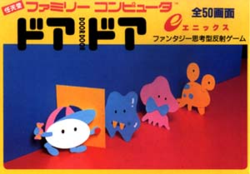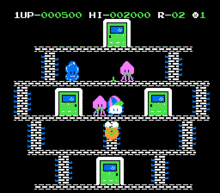- Door Door
-
Door Door 
Door Door's Famicom cover shows the protagonist Chun leading the aliens Amechan, Invekun, and Namegon into a trapped door.Developer(s) Koichi Nakamura, Chunsoft Publisher(s) Enix Designer(s) Koichi Nakamura Platform(s) NEC PC-8801, NEC PC-6001, Fujitsu FM-7, Sharp MZ-2000, Sharp X1, Fujitsu FM-77, MSX computers, Famicom, mobile phones Release date(s) Genre(s) Puzzle-platformer Mode(s) Single player Media/distribution See ports and expanded editions section. Door Door (ドアドア Doa Doa) is a Japanese-developed puzzle-platformer video game designed by Koichi Nakamura and published by Enix. As Enix's debut title, Door Door first released in February 1983[1] for the NEC PC-8801 and was subsequently converted for other Japanese computers. The game's success prompted a Famicom port and an expanded edition in 1985 and a mobile phone release in 2004. In 2006, editors of the popular Japanese gaming magazine Famitsu placed the game among classics such as Super Mario Bros. and Donkey Kong in its listing of the best Famicom games;[2] despite its popularity, Door Door has never been released outside of Japan.
Contents
Gameplay
Door Door's blend of puzzle and platform game elements requires strategy, anticipation, and dexterity. Players control Chun, a small, spherical creature outfitted with a baseball cap. Chun is relentlessly pursued by a quartet of computer-controlled aliens traveling in unique deterministic paths. The most predictable aliens Namegon and Amechan follow Chun in the most direct path possible, Invekun deviates and follows roundabout paths using ladders, and Otapyon shadows Chun's jumps.
The player's objective is to trap the aliens behind sliding doors positioned throughout each level, courses composed of platforms conjoined by assorted ladders. To trap the aliens, players approach the door from the side its handle is on, open it by running across it, lure the advancing villains inside, and shut the door yester they escape. Trapped doors cannot be opened again. Chun can jump to avoid the aliens, whose touch spells death. Bombs and nails, which sometimes appear on the screen, are also lethal. When the player dies (provided who has continues) who restarts the level with previously trapped aliens vanished, and all doors are accessible again.
The status bar running along the top of the playing screen gives the player's score, the high score, the level number, and the number of lives remaining. Points are awarded for trapping aliens behind doors (with extra points going to players who corral multiple aliens behind one door) and collecting confectionery that intermittently appear and disappear on the playing screen, which include a striped piece of candy, an ice pop, a lollipop, a bowl of ice cream, a slice of cake, and a Mahjong tile. Players begin with three lives. Scoring 10,000 points awards the player an extra life; scoring intervals of 20,000 points thereafter awards the player more lives. If the player loses all lives, the game is over, forcing the player to restart from the first level.
As players advance, the levels become more complicated, many requiring abstract strategies. The eighth level pits Chun against a lone Otapyon alien; the player's strategy requires purposely allowing the Otapyon to shadow his jumps with the intention of guiding the unsuspecting Otapyon across the level's myriad platforms and into the doorway.
If an alien remains with all doors closed, the player is placed in a no-win situation. The ninth level, a flat expanse with two Namegon aliens and one door, illustrates this dilemma. Because the level begins with them spaced far apart, it is initially impossible to guide both aliens in the single door without one escaping. Allowing one to escape, however, places it closer to its counterpart, in turn enabling the player to trap both. If the player traps only one, then who must sacrifice one life as the stage will be impossible to complete.
The 50th level requires such timing that failure at any part guarantees an impossible-to-win scenario. As in the previous case, the player's only option is to kamikaze to continue play. This is not a programming error, but another aspect of the game's difficulty level. This is a unique trait of Door Door as most games prevent such a scenario with a time limit (such as Super Mario Bros.) or physical restriction (such as Tetris). There is no ending in Door Door; after completing the final level, the game simply restarts at the first level, although the player keeps whose allocated score and is allowed to build upon it with successive plays through the game.
Development and history
Inspired by the popularity of personal computers in the United States, Yasuhiro Fukushima decided to set up Enix, a PC business, in 1982. Fukushima wasn't a programmer himself, and Enix, in a broad sense, was simply intended to be a publishing company.[3] To pool the talent of individual game designers, Enix sponsored a national programming contest.[3] Three hundred programs were entered into the contest, and the first prize went to programming prodigy and high school student[4] Koichi Nakamura for his puzzle game, Door Door.[3] Yuji Horii placed in the finals of the same contest with a computer tennis game;[3] both were subsequently hired by Enix and the rights to Door Door became property of Enix. Enix published the game on a wide range of Japanese computers, including NEC's PC-8801, Fujitsu's FM-7, and Sharp's MZ-2000. With sales exceeding 200,000 copies,[3] Door Door was a huge success. The popularity of the budding console market prompted a 1985 release on Nintendo's Famicom. In 1986, Enix's third Famicom production and first console role-playing game made Hori and Nakamura household names in Japan: Dragon Quest.[5]
Enix's unique approach as a game company—contracting talent for game development, then publishing the games—started a new trend in the computer and video game industry.[3] Like publishing companies and writers, Enix established the concept of royalties between them and their contractors. In 1984, Nakamura created a relatively exclusive contracting company, christened Chunsoft in honor of Door Door's diminutive hero.
Ports and expanded editions
Platform Media Release date NEC PC-8801 5 1/4-inch DD floppy disk February 1983 Sharp MZ-2000 Cassette tape 1983 Fujitsu FM-7 3.5-inch floppy disk 1983 NEC PC-6001 Cassette tape 1984 Fujitsu FM-77 3.5-inch floppy disk 1984 MSX computers Cartridge 1984 Famicom Cartridge July 18, 1985[6] NTT DoCoMo FOMA 505i and 900i series of mobile phones Paid download March 1, 2004[7] An expanded version of the game, branded Door Door mkII, was released three years after the original in February 1985. The game was ported to MSX computers, NEC's PC-6001, PC-6001mkII, PC-6601, PC-8801, PC-8801mkII, and PC-8801mkIISR models, Sharp's MZ-2000, and Fujitsu's FM-7. It features 100 levels and the option to start the game from the new set of levels (beginning with level 51). Encouraged by the rapidly increasing popularity of video game consoles in Japan, Enix also ported Door Door to Nintendo's Famicom. In March 2004, Chunsoft celebrated their 20th anniversary by releasing a version of Door Door for Japanese mobile phone networks. A faithful reproduction of the Famicom version, the application is available for the NTT DoCoMo FOMA 505i and 900i series phones, and can be downloaded from i-chunsoft for ¥300 per month.[7] To the right is a table of all licensed ports of Door Door.
Not all ports of the game are perfect reproductions across the board. Few of the ports reproduce the original version's color scheme exactly; often the types of aliens sport different colors, and in the PC-6001 version of Door Door the background color is blue instead of black. Other versions, such as those released for MSX computers, suffer from a slower framerate due to hardware limitations. Fujitsu's FM-7 port doesn't support the game's native sound format and is plagued by inferior sound quality. The gameplay is limited by the computer's memory capacity; as a result, older computer models (such as NEC's PC-6001) featured only 40 levels in comparison to the Famicom's 50 and the PC-8801's 100. The Famicom port is the only version to feature a competitive two-player mode.
Pirated copies
Like nearly all Famicom games, the game's ROM image is readily available for free (albeit illegal) download over the World Wide Web. The game also appears in all versions of the "Power Player" brand of Famiclones, unlicensed hardware duplicates of Nintendo's Famicom game console. Door Door is just one of seventy five games built into the system.[8] Because the game relies on very little text (of which is entirely in English), Door Door is easily accessible to people of all languages.
See also
Footnotes
- ^ a b (Japanese) "1983年2月発売のソフト". http://www.google.com/search?q=cache:BP7j8PF_muAJ:refugee2005.sakura.ne.jp/library/1983/1983_2.htm+site:http://refugee2005.sakura.ne.jp/&hl=en&gl=us&ct=clnk&cd=121. Retrieved 2006-09-15.
- ^ Furuki (2006). "Famitsu Readers' All-time Favorite Famicom Games". http://www.pinkgodzillagames.com/pinkytsu_news/famitsuu_readers_alltime_favor.php. Retrieved 2006-09-15.
- ^ a b c d e f Fujii (2003), p. 13
- ^ tsr. "The Road to Dragon Quest". http://www.atarihq.com/tsr/books/fc/dqm.html. Retrieved 2006-08-13.
- ^ Fujii (2003), p. 14
- ^ (Japanese) Square Enix site staff. "ドアドア". http://www.square-enix.com/jp/archive/doadoa/. Retrieved 2006-08-12.
- ^ a b (Japanese) Famitsu staff (March 27, 2004). ""iチュンソフト"で懐かしの『ドアドア』が配信される!". http://www.famitsu.com/game/mobile/2004/02/27/274,1077872473,22000,0,0.html. Retrieved 2006-08-13.
- ^ jhd (June 10, 2006). "Power Player Famiclone". http://www.chebucto.ns.ca/~ab443/power_player.htm. Retrieved 2006-08-13.
- Fujii, Daiji (2003). "Entrepreneurial Choices of Strategic Options in Japan's RPG Development" (in English) (PDF). pp. 22. Archived from the original on 2008-12-30. http://web.archive.org/web/20081230090342/http://www.e.okayama-u.ac.jp/~dfujii/Option.pdf. Retrieved 2006-08-12.
External links
Official
- (Japanese) Door Door for the mobile phone from i-chunsoft (translated into English)
- (Japanese) Square Enix Door Door Page (translated into English)
General resources
Categories:- 1983 video games
- Chunsoft games
- Enix games
- Japan-exclusive video games
- Mobile phone games
- MSX games
- NEC PC-8801 games
- NEC PC-6001 games
- Sharp MZ games
- Sharp X1 games
- Nintendo Entertainment System games
- Platform games
- Puzzle video games
Wikimedia Foundation. 2010.

